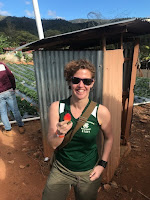Youth Development in the Dominican Republic
By Melanie Forstrom, Farmer-to-Farmer (F2F) Volunteer
 Being
the first volunteer of a cycle gave me the exciting opportunity to contribute
to and shape the youth involvement strategy for the following 5 years in the Dominican Republic. I was mainly stationed in Santo Domingo but had the
opportunity to travel to Jarabacoa and Mao. There I saw and experienced organic
strawberry and banana production, talked to young producers, and had rich
conversations about protecting the basins of the Rio Yaque del Norte.
Being
the first volunteer of a cycle gave me the exciting opportunity to contribute
to and shape the youth involvement strategy for the following 5 years in the Dominican Republic. I was mainly stationed in Santo Domingo but had the
opportunity to travel to Jarabacoa and Mao. There I saw and experienced organic
strawberry and banana production, talked to young producers, and had rich
conversations about protecting the basins of the Rio Yaque del Norte.

This was accomplished through research, surveys and meetings with host organizations and young producers. I produced a SWOT Analysis of each of the 3 organization partnering to incentivize youth agriculture in the Dominican Republic, as well as of the youth sector overall.
My assessment that a smaller scale mentoring program with each producer teaching 1-2 youth is the most viable path for the next five years, until there are additional incentives for producers to educate younger youth. If there is then enough interest to sustain a 4-H club model, this could happen further down the road.
 Being
the first volunteer of a cycle gave me the exciting opportunity to contribute
to and shape the youth involvement strategy for the following 5 years in the Dominican Republic. I was mainly stationed in Santo Domingo but had the
opportunity to travel to Jarabacoa and Mao. There I saw and experienced organic
strawberry and banana production, talked to young producers, and had rich
conversations about protecting the basins of the Rio Yaque del Norte.
Being
the first volunteer of a cycle gave me the exciting opportunity to contribute
to and shape the youth involvement strategy for the following 5 years in the Dominican Republic. I was mainly stationed in Santo Domingo but had the
opportunity to travel to Jarabacoa and Mao. There I saw and experienced organic
strawberry and banana production, talked to young producers, and had rich
conversations about protecting the basins of the Rio Yaque del Norte. The main outcome of my assignment was creating a draft youth development strategy.

This was accomplished through research, surveys and meetings with host organizations and young producers. I produced a SWOT Analysis of each of the 3 organization partnering to incentivize youth agriculture in the Dominican Republic, as well as of the youth sector overall.
My assessment that a smaller scale mentoring program with each producer teaching 1-2 youth is the most viable path for the next five years, until there are additional incentives for producers to educate younger youth. If there is then enough interest to sustain a 4-H club model, this could happen further down the road.

.png)

Comments
Post a Comment